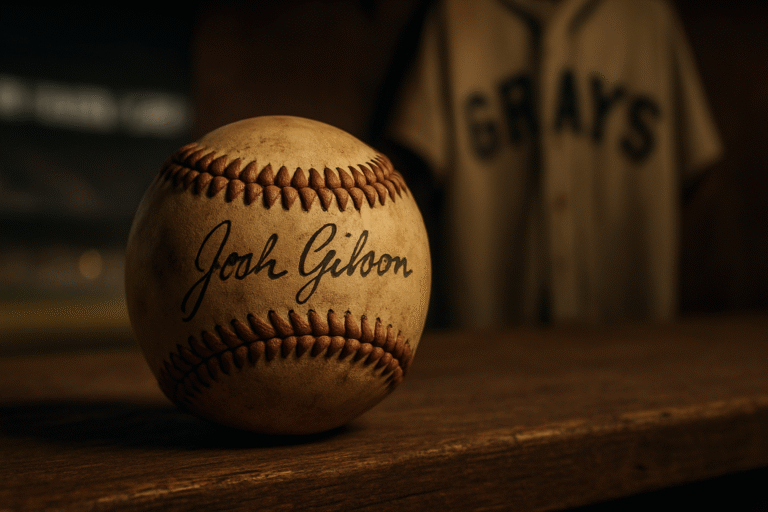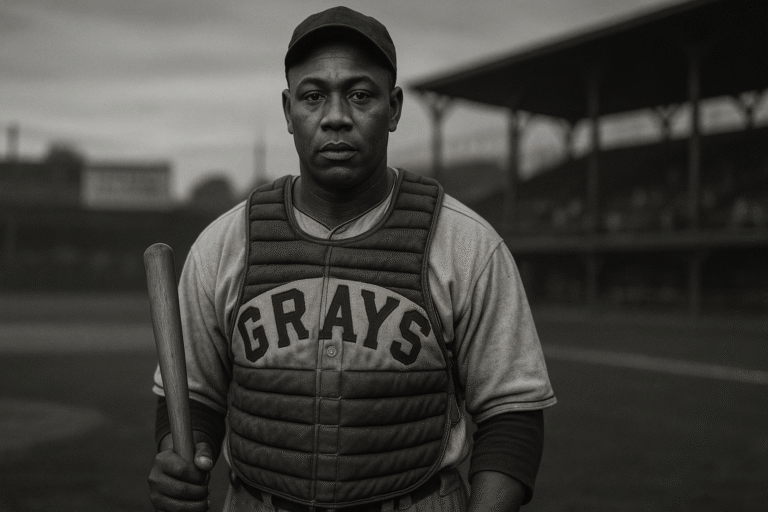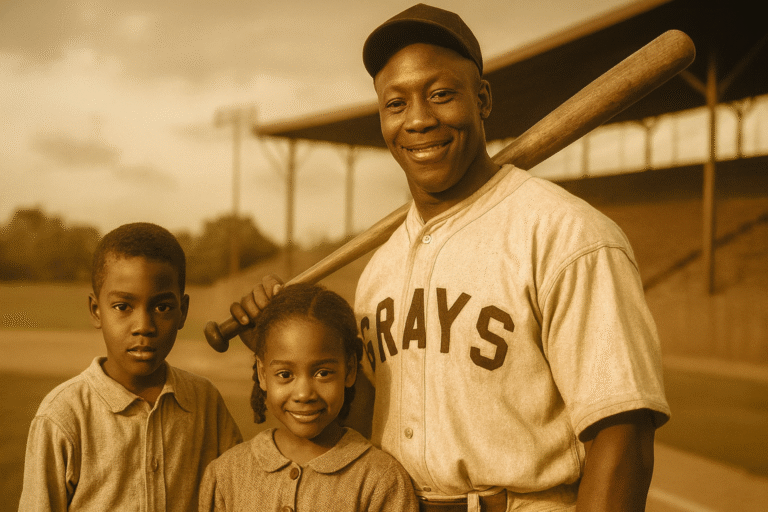- Key Takeaways
- Josh Gibson’s Early Life In Pittsburgh
- Growing Up in Pittsburgh: Family, Neighborhood, and Work
- Finding Baseball: Sandlots, Factories, and Teenage Leagues
- The Road to the Negro Leagues: Big Breaks and Local Legends
- Power, Presence, and Early Heroics
- Hardships, Loss, and Private Struggles
- Early Stardom and a Legacy That Grew Bigger
- Ask Me Anything: Gibson’s Early Years
- Why Gibson’s Early Story Still Matters
Key Takeaways
- Josh Gibson’s early years in Pittsburgh shaped both his skill and character.
- He rose from sandlot games to the Negro Leagues before turning 20.
- His family’s move from Georgia reflected the Great Migration story shared by many Black families.
- Gibson’s humility and strength earned respect beyond his power at the plate.
- Pittsburgh’s Hill District remains central to his legacy and baseball history.
Josh Gibson’s Early Life In Pittsburgh
Pittsburgh baseball fans know names like Roberto Clemente and Honus Wagner, but Josh Gibson’s story often feels bigger than just one city. Even if you’re a casual follower of baseball history, Gibson’s early years are worth getting into.
His journey from the neighborhoods of Pittsburgh to the legends of the Negro Leagues is both inspiring and, honestly, a little bittersweet. I’ve always felt like learning about his beginnings says as much about American life as it does about Gibson as a player.

Growing Up in Pittsburgh: Family, Neighborhood, and Work
Josh Gibson’s early life didn’t start in Pittsburgh, which surprised me when I dug into his background. He was born in Buena Vista, Georgia, in December 1911.
Like many Black families in the South, the Gibsons faced limited opportunities and hard living, prompting the family to make the move north, settling in Pittsburgh when Josh was about 10. This migration wasn’t unusual at all; thousands of families were leaving the Jim Crow South, hoping for more stable jobs and fairer treatment up north. Pittsburgh’s steel mills and busy neighborhoods brought different challenges, though.
I get the sense that Gibson’s family was close. His father found work as a laborer, and the family joined a thriving Black community centered around Pittsburgh’s Hill District. That area had so much character: jazz, small businesses, churches, and plenty of sandlot baseball fields.
Young Josh split his time between school and helping support his family. Money was always tight, and Gibson left school around age 15 to work as an apprentice at Gimbel’s department store. That’s where he first got the nickname “the Black Babe Ruth,” at least according to some stories. Maybe that nickname came later, but either way, his power at the plate was already turning heads.
Finding Baseball: Sandlots, Factories, and Teenage Leagues
Baseball meant more than just recreation for working-class kids in Pittsburgh. For boys like Josh, it was part pastime and part lifeline, an escape from tough city jobs and sometimes the only way to be noticed. I can almost picture those dusty fields and the pickup games that drew in local legends and dreamers alike.
Most of Gibson’s baseball education came outside organized leagues, since segregation meant Black players couldn’t join white teams. He played wherever he could find a game. Playgrounds, sandlots, makeshift teams aligned with local factories. His first serious club was the semipro Pleasant Valley Red Caps, a team known for giving ambitious kids real chances.
Word started spreading about this large, quiet teenager who could hit baseballs farther than anyone else. Not everyone believed the stories at first. Could a 16-year-old really launch balls over 400 feet? It almost seemed unbelievable.
By the time Gibson reached his mid-teens, he was catching for several neighborhood teams and sometimes pitching too. The combination of his size—over six feet tall and very strong—and his raw talent wasn’t lost on Pittsburgh’s local managers. I think about how word-of-mouth worked back then. If you blew people away at a sandlot game, your name made the rounds within days.
Gibson’s reputation grew locally much faster than you might expect for someone so young and quiet. Those street and sandlot games must have been electric, and Gibson’s might at the plate became almost mythic among young players who wanted to follow in his footsteps.
This environment not only honed his skills but also gave him a deep sense of belonging in Pittsburgh’s Black neighborhoods. Teams were coiled around these sandlot fields, schools, and factory leagues, and baseball was a way to both fit in and stand out. For some kids, including Gibson, it was the best path to local respect and possibly a shot at something bigger.
The Road to the Negro Leagues: Big Breaks and Local Legends
Not every baseball great gets discovered by accident, but that’s more or less what happened with Gibson. He didn’t have organized tryouts or a pipeline to pro scouts. In 1928, when Josh was only 16 or 17, his break came as a little bit of luck and tragedy.
Gibson had been playing for a factory team when he caught the eye of a scout linked to the Homestead Grays. The Grays were the pride of Pittsburgh’s Black baseball scene, sometimes called the “Yankees of the Negro Leagues.”
In 1930, the Homestead Grays’ regular catcher injured his hand during a game at Forbes Field. The manager, desperate for a substitute, called on Gibson, who was watching from the stands. Coming straight from the crowd to the field feels almost like a folk tale, but it really happened.
Once Gibson started catching for the Grays, there was basically no looking back. He fit right in and, by everyone’s account, handled the game, pressure and all, with a surprising calm.
During those first years, he was still a teenager playing against grown men and established stars. The pace of his rise and how quickly he went from sandlots to the Grays says a lot about his talent, but also the way opportunity sometimes knocked all at once for Black ballplayers.
Not everyone got the same chance, though. Gibson just happened to be at the right place, right time, and ready. His friends joked that one day he would be famous, but nobody could have known just how quickly he would climb.
Pittsburgh’s baseball community started buzzing with excitement. More fans showed up at games, eager to see if the stories about Gibson were true. Neighborhood boys would hang around ballparks just for a chance to catch a glimpse, hoping to see a home run that became the talk of the Hill District the next morning.
Power, Presence, and Early Heroics
You can’t talk about Josh Gibson’s early days without mentioning his home runs. I’ve read stories from folks who claim he cleared ballparks that even white major leaguers struggled with. The numbers are tricky, since Negro League stats weren’t officially tracked, but eyewitnesses agree that nobody in Pittsburgh had ever seen pop off a bat like Gibson’s before. Some even say his balls left Forbes Field entirely, rolling down the Oakland streets in the evening light.
What made these feats even more impressive was the setting. Negro League players dealt with poor gear, rocky fields, and a travel schedule that sounds exhausting by today’s standards. Still, Gibson stood out for his focus and natural sense behind the plate.
I get the impression that even as a teen, he was respected for his attitude—steady, hardworking, and never one to brag about his power. It inspired teammates, which goes a bit against the “larger-than-life” myth. In reality, Gibson kept it pretty humble, at least off the field.
His presence changed the dynamic of the teams he played on. Not only was he physically imposing, but he brought a kind of quiet leadership that teammates looked up to. Managers in Pittsburgh, and soon across other cities, began planning how to defend against him.
As his fame grew, so did the legends—stories of lost balls and astonished outfielders, each one adding to Gibson’s early lore. Even local papers started sending reporters to cover Grays’ games, hoping to get a scoop or a quote from fans about the kid who seemed destined for something extraordinary.
Hardships, Loss, and Private Struggles
The early years weren’t all smooth for Gibson, and ignoring that part leaves out what shaped his character. At 18, he married Helen Mason. The couple was expecting twins when tragedy hit. Helen died in 1930 due to complications from childbirth, leaving Gibson a grieving single father at a young age, just as his baseball career was taking off.
I’ve always been moved by this part of his story. It’s one of those moments where, as much as people like to talk about his stats, the personal losses make his accomplishments feel even more remarkable.
Gibson relied on family and friends for support and continued playing through his grief. He spent more time with his team than at home, traveling for games and chasing contracts. Baseball became both his escape and his livelihood.
The schedule was demanding, a grind of barnstorming trips, night trains, and games in cities across the Midwest and Northeast. But for Gibson, it seems the game also dulled some pain, even if only a little. Those bonds formed on the road became as important as family, offering both distraction and comfort.
Despite those hardships, Gibson rarely let his pain show on the field. Fans noticed his focus, and teammates learned to trust him in tight situations. He played with passion, but never with anger, and that balance seemed to help him pull through the darkest periods.
Pittsburgh’s community stepped up as well, with friends helping care for his young son and neighbors looking out for him when travel kept him away. Those early trials gave Gibson layers of resilience that would help define not just his career, but his reputation off the field, as someone people admired and rooted for beyond his skills with a bat.
Early Stardom and a Legacy That Grew Bigger
By his early twenties, Josh Gibson was already among the best players in the Negro Leagues. His time with the Homestead Grays and, briefly, the Pittsburgh Crawfords put him front and center in some of the most competitive baseball outside MLB.
Fans came in droves for a chance to watch him, and sportswriters in Black newspapers started to compare his stats to white stars. The buzz about Gibson began to seep beyond Pittsburgh; even fans from other cities followed his games through word of mouth and newspaper box scores.
Some stories about Gibson’s home runs might sound exaggerated, but they’re constantly told by people who watched, so who am I to argue? Opposing pitchers started adjusting their strategies just for him, sometimes walking him to avoid another highlight.
That’s the level of respect he earned, really early. Even in towns where the Grays were visiting, people packed parks hoping to see one of his classic towering shots.
All this happened well before he hit what would usually be a ballplayer’s prime. That’s probably what floors me most when looking back. Gibson’s early life in Pittsburgh gave him both the thick skin and the roots he needed, pushing him on toward bigger stages with confidence.
There’s some sadness in realizing he never got to play Major League Baseball; segregation kept him and so many others locked out, but Pittsburgh was where he became a legend, long before the national headlines started printing his name.
Gibson’s popularity also helped build bridges within the scattered world of Black baseball in the 1930s. He played in all-star games, exhibition matchups, and even off-season barnstorming trips. On these trips, he sometimes faced white Major League players in unsanctioned games, holding his own and winning praise from fans of every background, even if the wider baseball world wouldn’t officially recognize his talents until decades later.
Ask Me Anything: Gibson’s Early Years
I get a lot of questions about Josh Gibson’s roots. Here are a few that pop up most often when I’m chatting with other fans or young players getting into baseball history:
Answer: Not exactly. He played several positions, but catching ultimately proved to be his best fit due to his strong arm and quick thinking. His size helped, too.
Answer: Honestly, pretty fast. Local managers noticed him before he was 18, and full-time Negro League play followed almost right away after his chance with the Grays. He became a star in just a couple of seasons.
Answer: This one’s tough to answer with total confidence, but it seems like family and baseball itself both played a role. A sense of duty to his son, and the game serves as an outlet for grief.
Answer: Absolutely. His stints with the Homestead Grays and Pittsburgh Crawfords put him alongside Cum Posey, Oscar Charleston, and Satchel Paige, among others.
Answer: Today, you can find murals, plaques, and even a field named in his honor around the Hill District and Homestead. Fans and local historians have worked to keep his memory alive and give younger generations a connection to his roots in the city.
Why Gibson’s Early Story Still Matters
Jumping into the early life of Josh Gibson always leaves me thinking about what gets lost when we only look at players’ stats. Gibson’s roots in Pittsburgh—the family struggles, his quick rise, even the heartbreak—add depth to everything he accomplished. His story isn’t only about home runs; it’s about what happens when opportunity, grit, and a little bit of timing come together at the right moment.
Pittsburgh shaped more than just Gibson’s swing. The city gave him a community and a place to chase his dreams, and it’s still where his legacy stands tallest. For anyone curious about the heart of baseball history, that’s a story well worth remembering. His legend remains, thanks to the city’s devotion to sharing his story and the echoes of those games played under the steel shadows and city lights.



